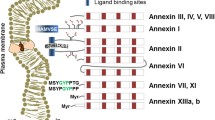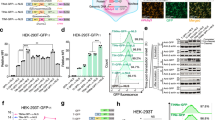Abstract
Biomolecules such as proteins, DNA, and RNA are macromolecules and can not cross the cell membrane. However, cell-penetrating peptide (CPP) has been shown to deliver therapeutic biomolecules successfully into cells. The various and widely used CPPs including TAT, VP22, and Antp are mostly non-human originated CPPs, and are limited by their potential toxicity and immunogenicity. We report here on a newly identified novel cell-penetrating sequence (LPIN; RRKRRRRRK) from the nuclear localization sequence (NLS) of human nuclear phosphatase, LPIN3. LPIN-EGFP recombinant protein was concentration- and time-dependently delivered into cells and localized to the nucleus as well as the cytoplasm. It penetrated the cell membrane by lipid raft-mediated endocytosis by binding to heparan sulfate proteoglycan. LPIN-EGFP was successfully delivered into primary mouse splenocytes in vitro and it could be delivered into various tissues including liver, kidney, and intestine in mice after intra-peritoneal injection. This research suggests that LPIN-CPP could be used in a drug delivery system to deliver therapeutic biomolecules including peptides, proteins, DNA, and RNA and without the limitations of non-human originated CPPs such as TAT-CPP.
Similar content being viewed by others
References
Choi, J.M., Ahn, M.H., Chae, W.J., Jung, Y.G., Park, J.C., Song, H.M., Kim, Y.E., Shin, J.A., Park, C.S., Park, J.W., et al. (2006). Intranasal delivery of the cytoplasmic domain of CTLA-4 using a novel protein transduction domain prevents allergic inflammation. Nat. Med. 12, 574–579.
Choi, J.M., Kim, S.H., Shin, J.H., Gibson, T., Yoon, B.S., Lee, D.H., Lee, S.K., Bothwell, A.L., and Lim, J.S. (2008). Transduction of the cytoplasmic domain of CTLA-4 inhibits TcR-specific activation signals and prevents collagen-induced arthritis. Proc. Natl. Acad. Sci. USA 105, 19875–19880.
Choi, J.M., Shin, J.H., Sohn, M.H., Harding, M.J., Park, J.H., Tobiasova, Z., Kim, D.Y., Maher, S.E., Chae, W.J., Park, S.H., et al. (2010). Cell-permeable Foxp3 protein alleviates autoimmune disease associated with inflammatory bowel disease and allergic airway inflammation. Proc. Natl. Acad. Sci. USA 107, 18575–18580.
Choi, J.M., Sohn, J.H., Park, T.Y., Park, J.W., and Lee, S.K. (2012). Cell permeable NFAT inhibitory peptide Sim-2-VIVIT inhibits Tcell activation and alleviates allergic airway inflammation and hyper-responsiveness. Immunol. Lett. 143, 170–176.
De Coupade, C., Fittipaldi, A., Chagnas, V., Michel, M., Carlier, S., Tasciotti, E., Darmon, A., Ravel, D., Kearsey, J., Giacca, M., et al. (2005). Novel human-derived cell-penetrating peptides for specific subcellular delivery of therapeutic biomolecules. Biochem. J. 390, 407–418.
Derossi, D., Joliot, A.H., Chassaing, G., and Prochiantz, A. (1994). The third helix of the Antennapedia homeodomain translocates through biological membranes. J. Biol. Chem. 269, 10444–10450.
Deshayes, S., Morris, M.C., Divita, G., and Heitz, F. (2005). Cellpenetrating peptides: tools for intracellular delivery of therapeutics. Cell Mol. Life Sci. 62, 1839–1849.
Donkor, J., Sariahmetoglu, M., Dewald, J., Brindley, D.N., and Reue, K. (2007). Three mammalian lipins act as phosphatidate phosphatases with distinct tissue expression patterns. J. Biol. Chem. 282, 3450–3457.
Duchardt, F., Ruttekolk, I.R., Verdurmen, W.P., Lortat-Jacob, H., Burck, J., Hufnagel, H., Fischer, R., van den Heuvel, M., Lowik, D.W., Vuister, G.W., et al. (2009). A cell-penetrating peptide derived from human lactoferrin with conformation-dependent uptake efficiency. J. Biol. Chem. 284, 36099–36108.
Eguchi, A., Meade, B.R., Chang, Y.C., Fredrickson, C.T., Willert, K., Puri, N., and Dowdy, S.F. (2009). Efficient siRNA delivery into primary cells by a peptide transduction domain-dsRNA binding domain fusion protein. Nat. Biotechnol. 27, 567–571.
Elliott, G., and O’Hare, P. (1997). Intercellular trafficking and protein delivery by a herpesvirus structural protein. Cell 88, 223–233.
Fischer, R., Kohler, K., Fotin-Mleczek, M., and Brock, R. (2004). A stepwise dissection of the intracellular fate of cationic cellpenetrating peptides. J. Biol. Chem. 279, 12625–12635.
Frankel, A.D., and Pabo, C.O. (1988). Cellular uptake of the tat protein from human immunodeficiency virus. Cell 55, 1189–1193.
Heitz, F., Morris, M.C., and Divita, G. (2009). Twenty years of cellpenetrating peptides: from molecular mechanisms to therapeutics. Br. J. Pharmacol. 157, 195–206.
Hotchkiss, R.S., McConnell, K.W., Bullok, K., Davis, C.G., Chang, K.C., Schwulst, S.J., Dunne, J.C., Dietz, G.P., Bahr, M., McDunn, J.E., et al. (2006). TAT-BH4 and TAT-Bcl-xL peptides protect against sepsis-induced lymphocyte apoptosis in vivo. J. Immunol. 176, 5471–5477.
Martin, M.E., and Rice, K.G. (2007). Peptide-guided gene delivery. AAPS J. 9, E18–29.
Morris, M.C., Depollier, J., Mery, J., Heitz, F., and Divita, G. (2001). A peptide carrier for the delivery of biologically active proteins into mammalian cells. Nat. Biotechnol. 19, 1173–1176.
Noguchi, H., Matsushita, M., Okitsu, T., Moriwaki, A., Tomizawa, K., Kang, S., Li, S.T., Kobayashi, N., Matsumoto, S., Tanaka, K., et al. (2004). A new cell-permeable peptide allows successful allogeneic islet transplantation in mice. Nat. Med. 10, 305–309.
Ogris, M., and Wagner, E. (2002). Targeting tumors with non-viral gene delivery systems. Drug Discov. Today 7, 479–485.
Reue, K., and Brindley, D.N. (2008). Thematic review series: glycerolipids. Multiple roles for lipins/phosphatidate phosphatase enzymes in lipid metabolism. J. Lipid Res. 49, 2493–2503.
Richard, J.P., Melikov, K., Vives, E., Ramos, C., Verbeure, B., Gait, M.J., Chernomordik, L.V., and Lebleu, B. (2003). Cell-penetra-ting peptides. A reevaluation of the mechanism of cellular uptake. J. Biol. Chem. 278, 585–590.
Rittner, K., Benavente, A., Bompard-Sorlet, A., Heitz, F., Divita, G., Brasseur, R., and Jacobs, E. (2002). New basic membranedestabilizing peptides for plasmid-based gene delivery in vitro and in vivo. Mol. Ther. 5, 104–114.
Schwarze, S.R., Ho, A., Vocero-Akbani, A., and Dowdy, S.F. (1999). In vivo protein transduction: delivery of a biologically active protein into the mouse. Science 285, 1569–1572.
Snyder, E.L., and Dowdy, S.F. (2004). Cell penetrating peptides in drug delivery. Pharm. Res. 21, 389–393.
Torchilin, V.P. (2005). Recent advances with liposomes as pharmaceutical carriers. Nat. Rev. Drug. Discov. 4, 145–160.
Valdearcos, M., Esquinas, E., Meana, C., Gil-de-Gomez, L., Guijas, C., Balsinde, J., and Balboa, M.A. (2011). Subcellular localiza-tion and role of lipin-1 in human macrophages. J. Immunol. 186, 6004–6013.
van den Berg, A., and Dowdy, S.F. (2011). Protein transduction domain delivery of therapeutic macromolecules. Curr. Opin. Biotechnol. 22, 888–893.
Wadia, J.S., Stan, R.V., and Dowdy, S.F. (2004). Transducible TAT-HA fusogenic peptide enhances escape of TAT-fusion proteins after lipid raft macropinocytosis. Nat. Med. 10, 310–315.
Zhao, J., Gao, P., Xiao, W., Fan, L.Q., Wang, F.J., Li, S.X., and Liu, J.W. (2011). A novel human derived cell-penetrating peptide in drug delivery. Mol. Biol. Rep. 38, 2649–2656.
Zorko, M., and Langel, U. (2005). Cell-penetrating peptides: mechanism and kinetics of cargo delivery. Adv. Drug Deliv. Rev. 57, 529–545.
Author information
Authors and Affiliations
Corresponding author
About this article
Cite this article
Lim, S., Kim, Wj., Kim, Yh. et al. Identification of a novel cell-penetrating peptide from human phosphatidate phosphatase LPIN3. Mol Cells 34, 577–582 (2012). https://doi.org/10.1007/s10059-012-0284-y
Received:
Revised:
Accepted:
Published:
Issue Date:
DOI: https://doi.org/10.1007/s10059-012-0284-y




